There's very little more interesting to me than reading authentic historical documents -- there's an immediacy and an "every-dayness" about them that can transport my imagination back in time to understand what life was like for people living through huge historical events. So, when I found a site online that sells old French newspapers... well, I had to get a few for myself!
Thanks, then, to the people at CadeauRetro.com for a fresh look at one of the most interesting periods in the recent history of the deep heart of France: that incredible weekend in June 1940 when Clermont-Ferrand became the capital city of France.
The last days of the French Republic
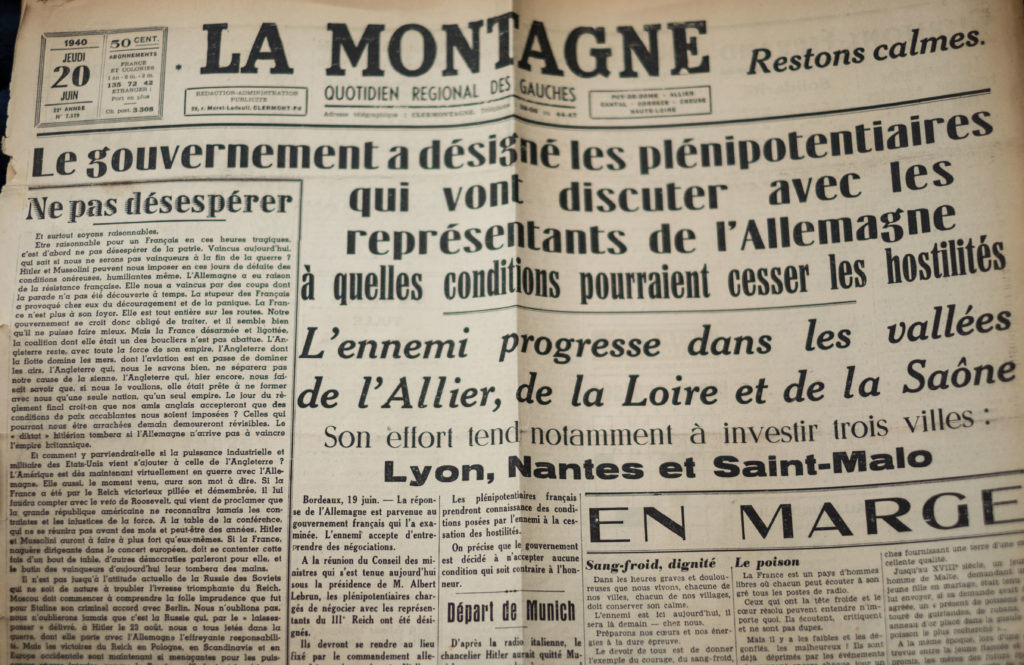
…and it wasn’t even necessarily the strangest day of a very strange month month for the people who lived there.
Things had fallen apart for France at an incredible speed in those earliest days of World War II.
As the German armies approached, the French government abandoned Paris in early June, 1940. Président du Conseil Paul Reynaud and his ministers landed first in Tours before ending up in Bordeaux. This was a government in chaos, shocked by how easy it was for Hitler’s armies to blast past the Maginot Line of defense, and paralyzed by the conflict between ministers who wanted to continue the fight and those who were ready to negotiate an immediate armistice.
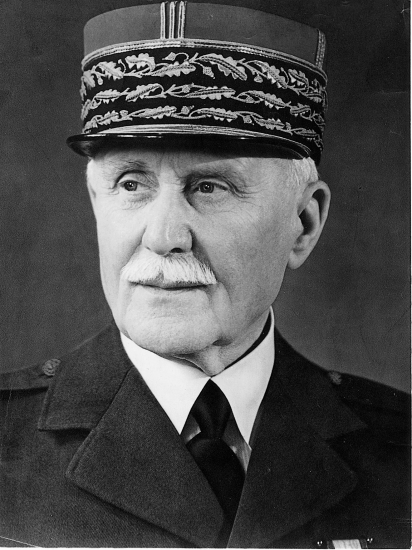
On June 14th, 1940, the Nazis marched into Paris. The whole northern half of France was in massive convulsion as 8 to 10 million people – French, Belgian, Dutch, Luxembourgers – pushed to the south to get away from the German invaders. The political infighting in Bordeaux intensified, as Paul Reynaud tried to get British help. He sent a largely unknown general named Charles de Gaulle to London, and in fact de Gaulle came back with a proposal for support from the Royal Air Force. But by the time he arrived in Bordeaux at 9:30 p.m. on June 16th it was too late – Reynaud had been forced to resign, and Philippe Pétain – the ancient maréchal of the French army, the “hero of Verdun” from World War I – was in charge.
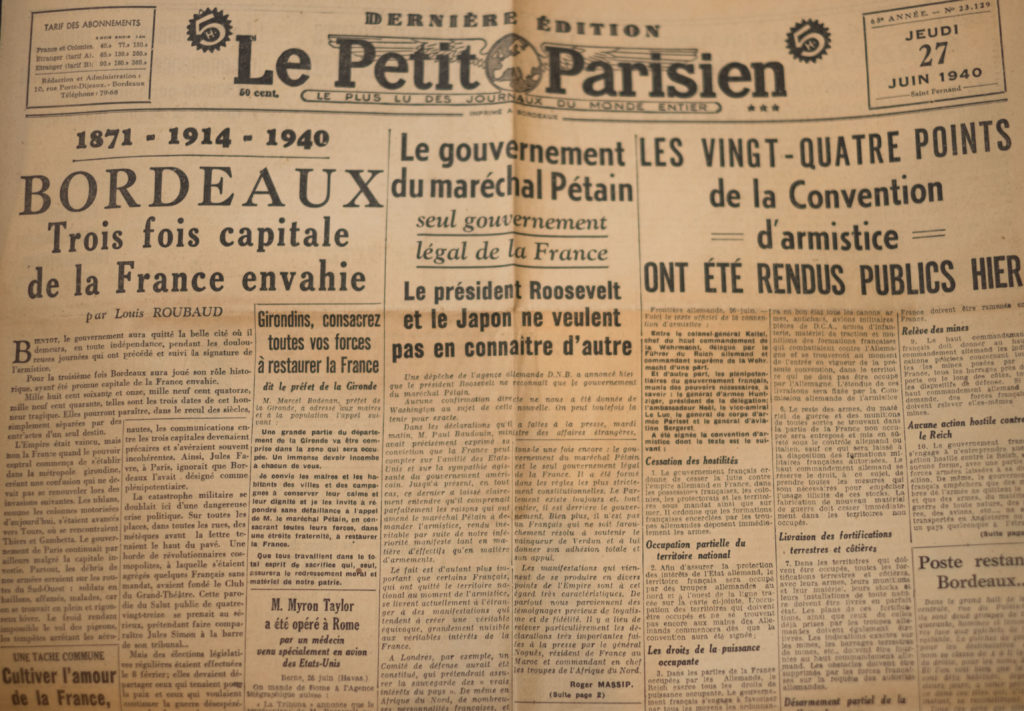
By the next day (June 17th) Pétain had formed a new government. The 84-year-old was among those who had no stomach for continuing the war, and he was on the radio that same day, justifying his call for an armistice.
With the French administration in chaos, the Germans moved aggressively to put the rest of the country under control. As they fanned out across the country, a Panzer division with 300 men under the command of Joseph Dietrich rolled into Clermont-Ferrand on June 21st, taking over the Prefecture and City Hall and setting themselves up in the Grand Hotel.
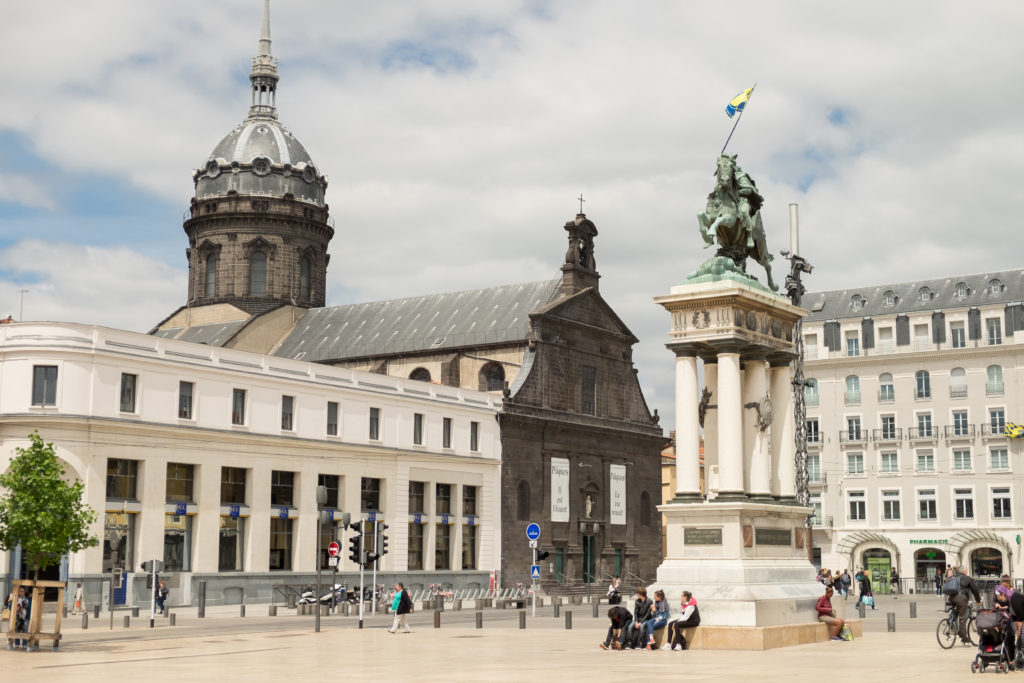
The German show of force lasted for a week. The Panzer division, loaded up with tires they had stolen from Michelin’s factories, headed east for St. Etienne on June 28th, leaving behind a Nazi administrative structure to supervise the years of occupation, the deportation of “Jews and undesirables” to German prison camps, and the intimidation of the Gestapo. Clermont-Ferrand would remain "under occupation" until it was liberated four years later on August 27th, 1944.
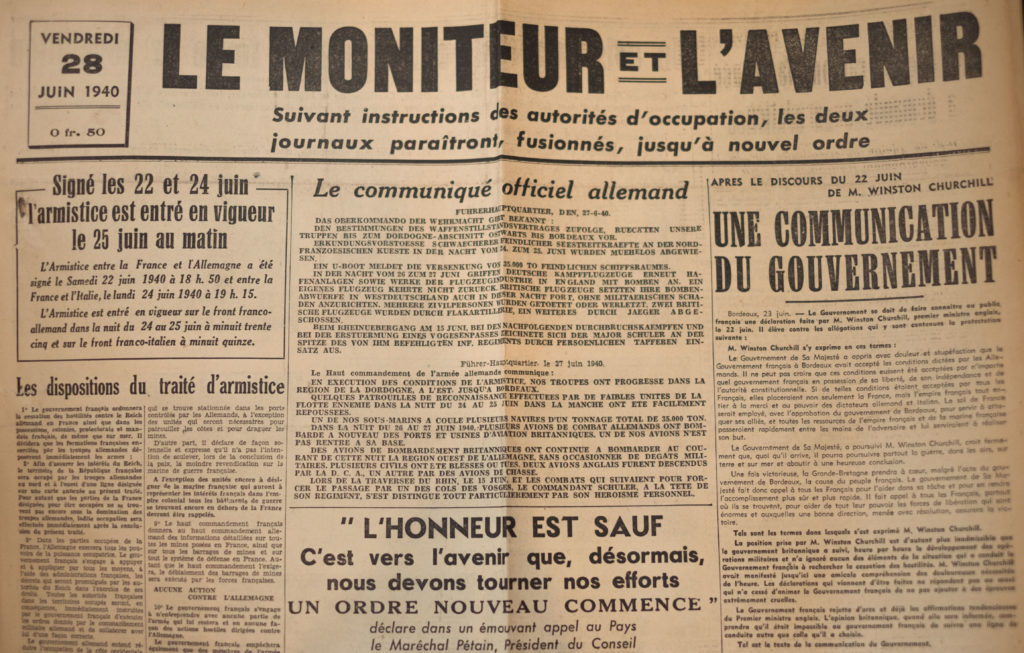
Clermont-Ferrand: The New Capital of France
So how did this modest city in the Auvergne become the capital of France? The Germans would not permit the French government to stay in Bordeaux – its position on the Atlantic coast was too strategic. By the time the armistice went into effect on June 26th, 1940, the country had been cut into “Occupied” and “Free” zones (even if "Free" still meant "under German control"), and the government went looking for a place to go in the “Free” zone.

Clermont-Ferrand must have seemed a logical choice – it was centrally located, away from the coasts, and politically more conservative than bigger cities like Lyon. The German troops left town on Friday, June 28th, and Philippe Pétain arrived with his new government on Saturday the 29th.
It’s hard to imagine the chaos that must have surrounded all these events. By this time, Charles de Gaulle had already begun broadcasting from London, denouncing Pétain for “treason” for giving up so easily to the Germans. The Exodus from the north had flooded Clermont’s streets with refugees; the status of French soldiers taken prisoner by the Germans was still unknown and terrifying to their families.
And into the midst of this misery came the elegant, aging figure of Philippe Pétain, thrust into a leadership role he had never imagined. I’ll say frankly that it’s hard to understand, looking back, how profoundly he was loved by so many French people at the time. But for many – probably most – Pétain represented calm and order and a promise that somehow France could get through this horrible period if it just fell back on “traditional values”. (Of course, at least some of these “traditional values” focused on cutting back the rights of women, deporting “undesirables” to concentration camps, and collaborating with the Nazis – all the elements of misery that came to characterize the shameful Vichy government.)
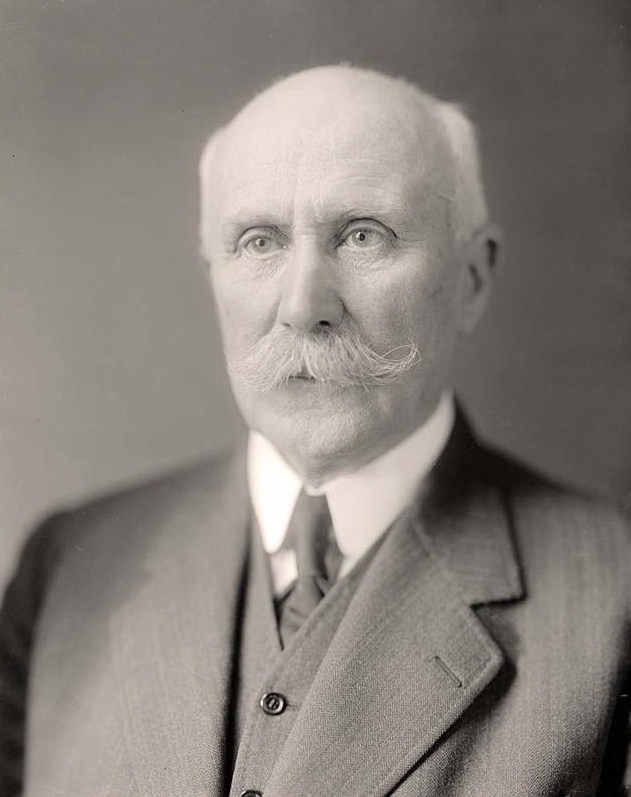
In the national memory, he embodies at the same time the victory of 1918, the shame of the summer of 1940, and the crimes of Vichy.- Encyclopédie Larousse
So, on this particular Saturday in June 1940, Pétain came to Clermont-Ferrand. He moved into the Michelin family’s traditional villa on the Cours Sablon. Welcomed by a mostly supportive crowd of Clermontois, Pétain set up offices in the black lava-stone Prefecture. The War Minister found offices in the suburb of Chamalières, the Justice Minister took over the local court building, the Minister of Foreign Affairs commandeered the school buildings of the Lycée Blaise Pascal, and the man in charge of Information moved into the offices of the local newspaper.
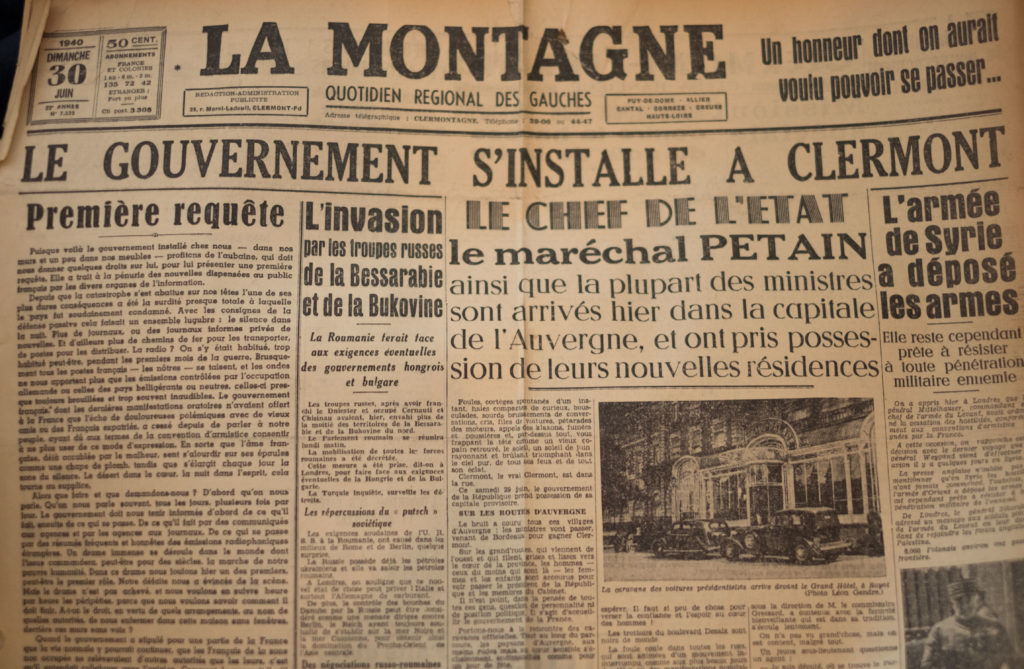
In all this commotion, it became obvious that while Clermont-Ferrand had many other good qualities, it didn’t have enough hotel rooms or lodgings to support the influx of bureaucrats, Nazi officers, and survivors of the Exodus all converging on the city. After a (very brief) period of thrashing around, the government decided to move one more time – to Vichy, 45 minutes north of Clermont-Ferrand. It was (and still is) a spa town, built to draw the luxury trade of tourists seeking a “cure” in the hot thermal baths that bubble up so frequently in this volcanic region of France. In short: lots of space to lodge an itinerant government and all its hangers-on.
On June 30th, Maréchal Pétain and many of his principal ministers packed up one last time and headed for Vichy. Some key government offices remained in Clermont-Ferrand until the end of the war, but the city’s reign as “the capital of France” had lasted just over 24 hours.
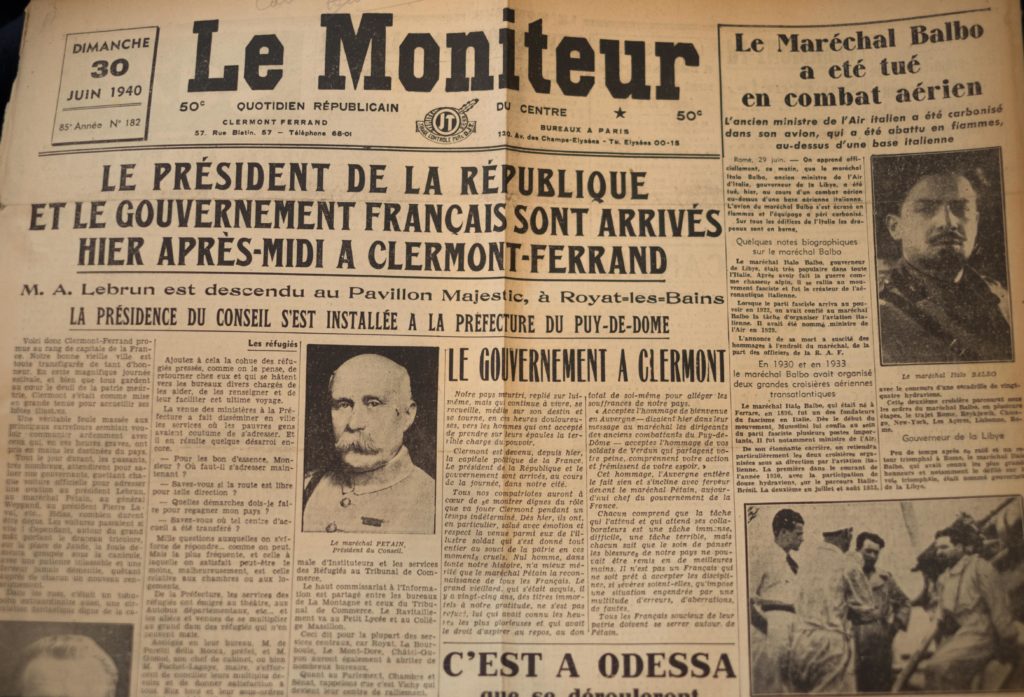
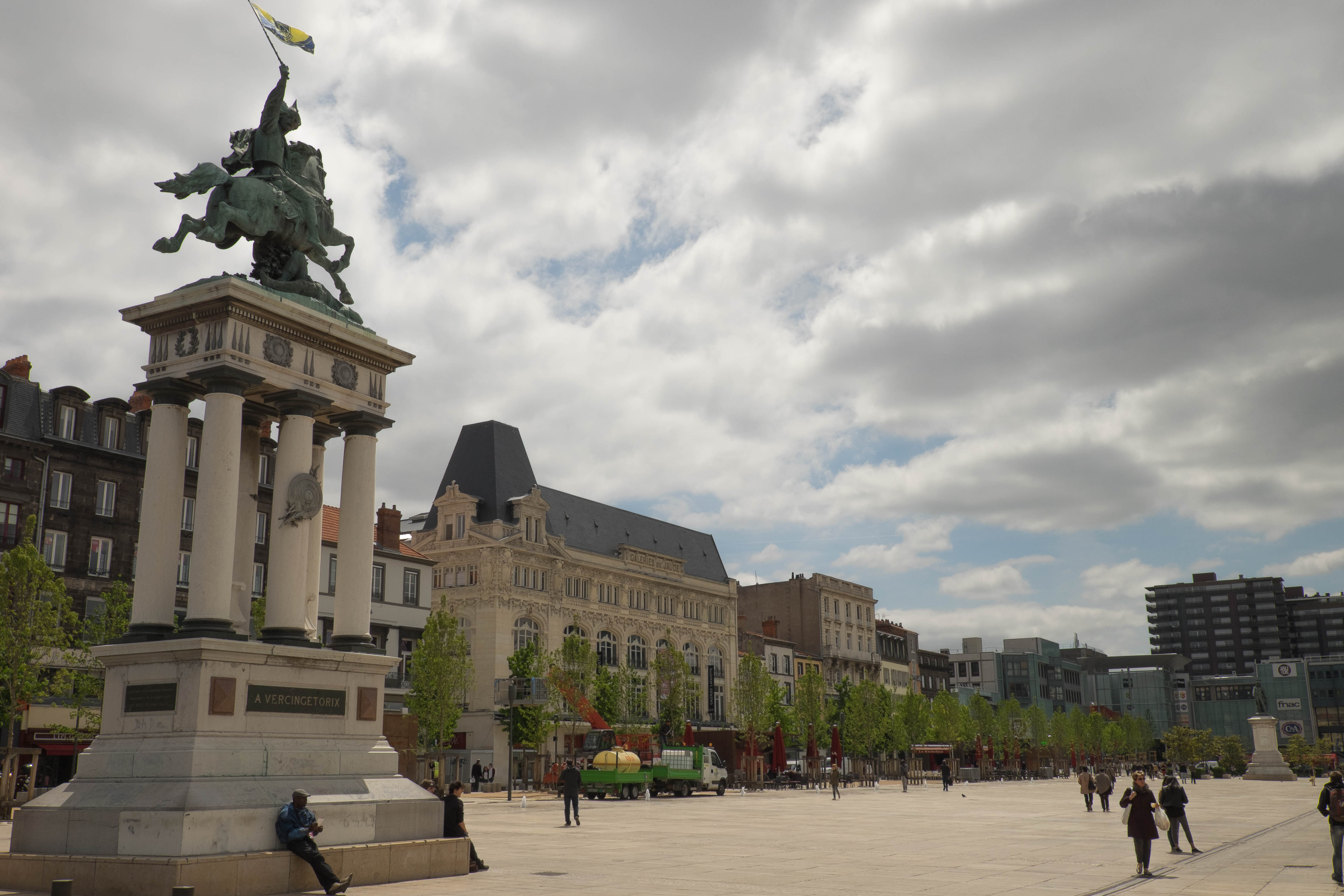
When I walk through the Place de Jaude now – particularly in the searing wet heat of a day in June – I try to imagine the anxiety and tension that must have electrified this great space during those days in 1940. Germans in their green summer uniforms, refugees stumbling under the weight of their bundled belongings, Pétain and his ministers sweating in wool suits…rumors swirling about the young man shot by the Germans under mysterious circumstances in Montferrand, the local police surrendering their weapons only to have them handed back when they agreed to cooperate with the Occupiers…people of every category living in fear for their sons in the army, their relatives stuck in the north…
Very few traces of this terrible month remain in the current landscape of Clermont-Ferrand. Many of the native citizens I’ve known don’t have any idea that their city was once the capital of France, and most history books gloss over the episode in a single sentence if they mention it at all. Given the nasty reputation history has correctly attached to the “Vichy government”, I’m sure les Clermontois prefer it that way!
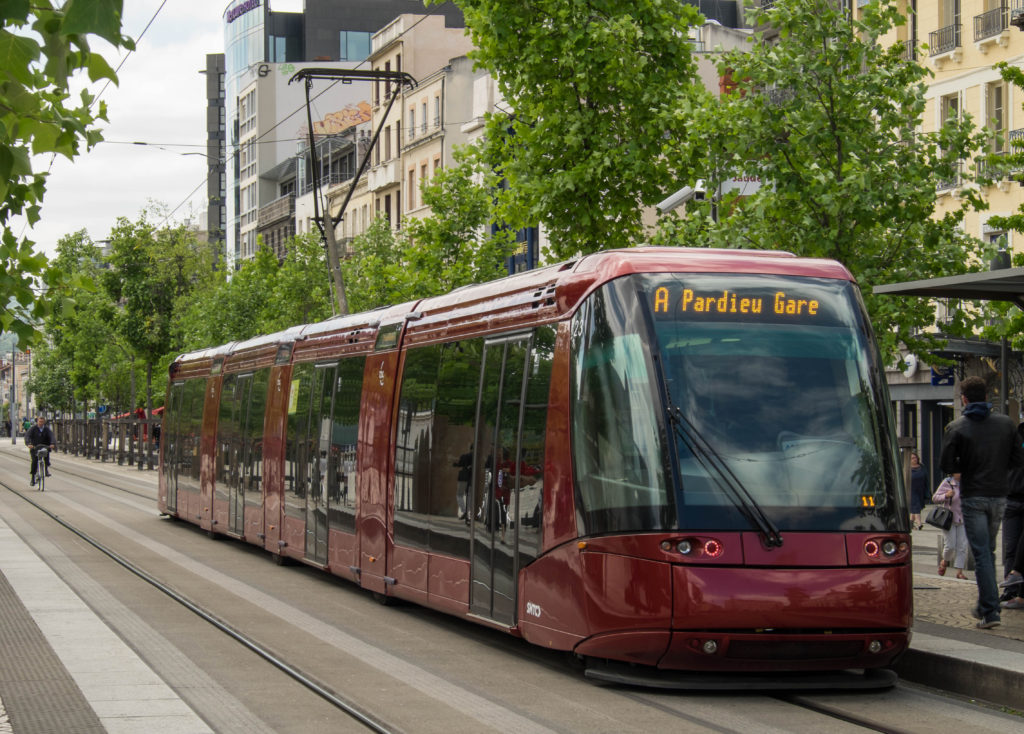
In your travels and reading about France, what traces of World War II have made the biggest impression on you? Please share your experiences in the comments space below! And while you're here, please take a second to share this post with someone else who is interested in the people, places, culture, and history of central France.
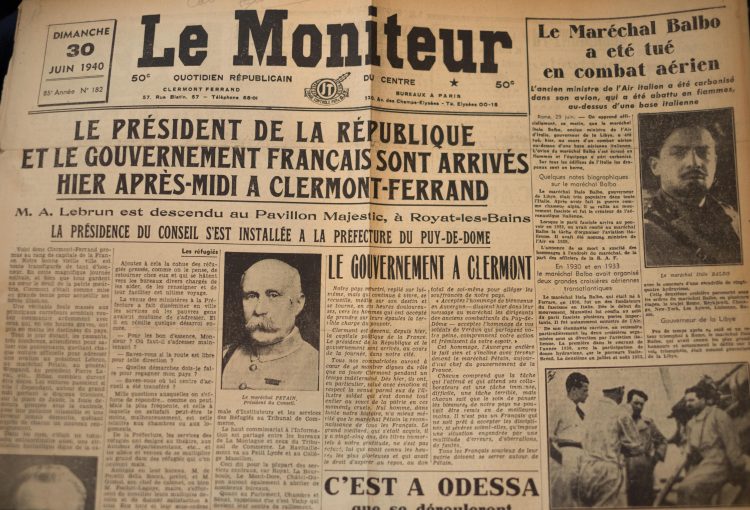

I am just loving your blog. I’ve saved this one for my husband to read – he’ll love it too. The History behind such places is great! Thanks #FlyAwayFriday
Thanks Alex – I appreciate your visit and the encouragement!
Thanks for this great article. My mother lived in Gannat France during the war, and went to a school in Claremont Ferrand called Fenelon. She told me about running for cover during bombing raids. I never realized that they were Allied bombs.
Thanks for writing, Henry. Yes, Clermont-Ferrand was bombed by the Allies — I think because of the industrial production there (primarily of tires). There’s still a Fenelon school (in fact, a complex of schools covering multiple levels), as there has been since 1908. I appreciate the comments!
Wow we’ve never had any posts shared on #FlyAwayFriday that included a detailed history lesson, I absolutely love it! My Dad always told me that I can’t enjoy travel if I don’t know the history behind the place! I’ll keep this in mind when I’m headed to France! Thanks for sharing on our linkup, hope to see you again this week!
Thank you for your very interesting explanation of how the Vichy government came to be in the town of Vichy after starting off in Clermont Ferrand. Most of my reading about the war has been based in Britain and it was not until recently, when I was doing some research on the war in my own town of Blois that I realised that the bombing was due to the allies and not the Gerrmans! The historical centre of Blois was badly bombed but fortunately other areas have retained their mediaeval and Renaissance buildings.
Thanks, Rosemary. Yes, we’ve seen some of the effects in Blois, too. And Clermont-Ferrand was also bombed by the Allies later in the war, primarily to cut off German access to the output from Michelin’s tire factories there. Not many traces remain, although there’s a stark reminder in a Clermont cemetery which has a small corner in which German soldiers are buried. Thanks for visiting the site!
No grave of germans soldiers of WW2 are present in cemetery of Clermont-Ferrand (Les Carmes). You make mistake with WWI germans soldiers grave.
Merci, Thibaut! You are absolutely correct — and I’m sorry to say that I knew this and still made the mistake in my response to a reader’s comment! I actually wrote a whole post about the “German corner” of the CFE cemetery 2 years before I wrote this comment, explaining how German soliders from World War ONE happened to be buried so far from the front lines of the war. (See https://www.deepheartoffrance.com/a-german-soldiers-cemetery-in-the-deep-heart-of-france/ ). Thanks for letting me know. (You are also correct about the photo of the Place de Jaude — I have since removed it from the post.)
What an interesting article about a very difficult time in France’s history. I love reading about history and you’ve made it easy to understand. Thank you.
Visiting from #AllAboutFrance
Thanks, Margo – I appreciate your visit and your comment!
Just finished watching Un Village Français and this blog is a nice epilogue. Have you seen the series?
The series is cued up next in our Amazon watch list – thanks for making the connection!
Like most people I imagine I had no idea of the part Clermond Ferrand played in establishing the Vichy regime. It’s a fascinating tale and must have been such an awful time to live through. Thanks for sharing it with #AllAboutFrance
We lived in Clermont-Ferrand, and I knew very little of this history… Sure brings a different perspective of some of the places we walked through every day, like Place de Jaude. It’s ironic – the ‘ancient’ history, such as surrounding the Mur des Sarrasins, is so prominent, while comparatively recent events (recent! but not in my lifetime) tend to disappear in the narrative of several centuries. Thanks for the informative post! Visiting via #AllAboutFrance
Working in Clermont-Fd and living in the neighbouring dept of Loire I found this interesting to read. Our small village here was named one of “Les Villages des Justes” in 2008, which is a history I’d like to explore further.
Hi, Alison. I hadn’t heard of “les villages des justes” until you mentioned it, but I have been interested recently to see in a couple of places — most recently St Pourcain sur Sioule — a new round of monuments to those who were deported or imprisoned by the Vichy regime. Thanks very much for your comment!
Another terrific entry, Richard! I had no idea that our home for five years was once — if only for a day — the capital of France. When people now ask me what it was like living in Paris, I will tell them I lived in the “other” capital!
Amitiés, Michael
Hi, Michael. It’s great to hear from you! Thanks very much for reading.
Cordialement.
Richard
Thank you, it’s interesting to read. My grandad was there in the camp 131 from May 1945 – April 1946 as prisoner de guerre. I couldn’t really find too much info about the camp, could anyone tell me where exactely it was? Thank you, Sylvia from Hungary
Thanks for writing, Sylvia. I’ve heard of Camp 131 and tried to find where it was actually located, but have not had any success so far. Do any other readers of the blog have an idea?
The Leibstandarte Adolf Hitler is not a Panzer Division in 1940. The picture of Place de Jaude with soldiers parade isn’t take the 21 june 1940. It’s the day where the germans of LSSAH enter in Clermont…